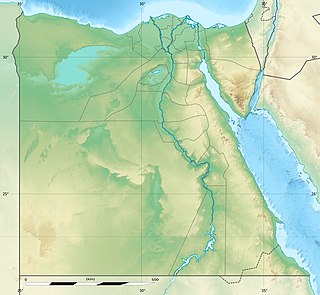
The Baghdad Nuclear Research Facility adjacent to the Tuwaitha "Yellow Cake Factory" or Tuwaitha Nuclear Research Center contains the remains of nuclear reactors bombed by Iran in 1980, Israel in 1981 and the United States in 1991. It was used as a storage facility for spent reactor fuel and industrial and medical wastes. The radioactive material would not be useful for a fission bomb, but could be used in a dirty bomb. Following the 2003 invasion of Iraq, the facility was heavily looted by hundreds of Iraqis, though it is unclear what was taken.

TRIGA is a class of nuclear research reactor designed and manufactured by General Atomics. The design team for TRIGA, which included Edward Teller, was led by the physicist Freeman Dyson.

The Bhabha Atomic Research Centre (BARC) formerly known as Atomic Energy Establishment, Trombay is India's premier nuclear research facility, headquartered in Trombay, Mumbai, Maharashtra. Founded by Homi Jehangir Bhabha Atomic Energy Establishment, Trombay (AEET) in January 1954 as a multidisciplinary research program essential for the india's nuclear program. It operates under the Department of Atomic Energy(DAE) which is directly overseen by the Prime Minister of India. In 1966 after the death of Homi Jehangir Bhabha AEET renamed as Bhabha Atomic Research Centre (BARC) BARC is a multi-disciplinary research centre with extensive infrastructure for advanced research and development covering the entire spectrum of nuclear science, chemical engineering, material sciences & metallurgy, electronic instrumentation, biology and medicine, supercomputing, high-energy physics and Plasma physics and associated research for Indian nuclear programme and related areas.

Research reactors are nuclear reactors that serve primarily as a neutron source. They are also called non-power reactors, in contrast to power reactors that are used for electricity production, heat generation, or maritime propulsion.

The National Atomic Energy Commission is the Argentine government agency in charge of nuclear energy research and development.
The advanced heavy-water reactor (AHWR) or AHWR-300 is the latest Indian design for a next-generation nuclear reactor that burns thorium in its fuel core. It is slated to form the third stage in India's three-stage fuel-cycle plan. This phase of the fuel cycle plan is supposed to be built starting with a 300MWe prototype in 2016. As of 2021 construction has not started and a firm date has not be set.
The Egyptian Atomic Energy Authority (EAEA) has been established in 1955. It leads the national research and development in the basic and applied peaceful nuclear research.

Nuclear power is the fifth-largest source of electricity in India after coal, gas, hydroelectricity and wind power. As of November 2020, India has 23 nuclear reactors in operation in 7 nuclear power plants, with a total installed capacity of 7,480 MW. Nuclear power produced a total of 43 TWh in 2020-21, contributing 3.11% of total power generation in India. 10 more reactors are under construction with a combined generation capacity of 8,000 MW.

Iran's nuclear program is made up of a number of nuclear facilities, including nuclear reactors and various nuclear fuel cycle facilities.
The Nuclear Fuel Factory (FCN)22.504°S 44.646°W is located near Resende, state of Rio de Janeiro, comprising three units, and has a production capacity of 280 tons of uranium per year. At present, FCN was modernized and produces at the Components and Assembly Unit the fuel rods and fuel elements needed for Brazilian nuclear reactors. The Reconversion and Pellets Production Unit is operating since 1999 with a capacity of 160 tons of UO2 pellets/year. The UO2 reconversion line uses the AUC process. The Nuclear Fuel Factory also produces other fuel element components, such as top and bottom nozzles, spacer grids and end plugs for export demands. Previously, Brazil supplied the uranium, which is transported to Canada where it’s converted into hexafluoride gas (UF6), and then to the United Kingdom for enrichment before it returns to Brazil for fabrication into fuel elements.

The Nuclear Fuel Complex (NFC) was established in 1971 as a major industrial unit of India's Department of Atomic Energy, as a nuclear plant also specializing in supply of nuclear fuel bundles and reactor core components. It is a unique facility where natural and enriched uranium fuel, zirconium alloy cladding and reactor core components are manufactured under one roof.

A neutron research facility is most commonly a big laboratory operating a large-scale neutron source that provides thermal neutrons to a suite of research instruments. The neutron source usually is a research reactor or a spallation source. In some cases, a smaller facility will provide high energy neutrons using existing neutron generator technologies.
President Adly Mansour announced on 7 November 2013 that Egypt was restarting its nuclear power program in El Dabaa; a deal was reached with the residents in which it was agreed that a residential area will also be built. The Egyptian minister of electricity, Ahmed Emam, has called the project "necessary" because of a small amount of renewable energy sources and not enough fuel.
ETRR-1 or ET-RR-1, is the first nuclear reactor in Egypt supplied by the USSR in 1958. The reactor is owned and operated by Egyptian Atomic Energy Authority (AEA) at the Nuclear Research Center in Inshas, 40–60 kilometres (25–37 mi) northeast of Cairo.

ETRR-2 or ET-RR-2, or is the second nuclear reactor in Egypt supplied by the Argentine company Investigacion Aplicada (INVAP) in 1992. The reactor is owned and operated by Egyptian Atomic Energy Authority (EAEA) at the Nuclear Research Center in Inshas, 60 kilometres (37 mi) northeast of Cairo.

EURATOM Cooperation Act of 1958 is a United States statute which created a cooperative program between the European Atomic Energy Community and the United States. In pursuant of the Atomic Energy Act of 1954, the cooperative program was an international agreement provisioning United States policy to establish power plants utilizing nuclear power technology within the European Atomic Energy Community territory. In accordance with the Act, the cooperative agreement sanctioned a civilian nuclear energy research and development program for the evaluation and observation of nuclear reactors selected by the Atomic Energy Commission and the European Atomic Energy Community.
the Hydrometallurgy Pilot Plant (HPP) is a hot cell laboratory complex, dedicated to perform bench-scale radiochemistry experiments including the separation of plutonium and uranium from the spent fuel rods of the ETRR-1 research reactor and was established in 1982. The HPP is owned and operated by the Egyptian Atomic Energy Authority (AEA) at the Nuclear Research Center in Inshas, northeast of Cairo.

Radioisotopes Production Facility (RPF), is a facility for the production of radioisotopes from irradiation of Low enriched uranium (LEU) in the Egyptian Second Research Reactor (ETRR-2) Complex. The RPF was supplied by the Argentine company Investigacion Aplicada (INVAP) and was commissioned during October and November 2011. The produced radioisotopes are used in medicine, industry and research activities for domestic market.
The Hot Laboratory and Waste Management Center (HLWMC), is dedicated for radioactive waste disposal as well as development of expertise in the back end of nuclear fuel cycle and radioisotope production for medical and industrial applications. The HLWMC was established in 1980, owned and operated by the Egyptian Atomic Energy Authority (AEA) in Inshas, northeast of Cairo.












